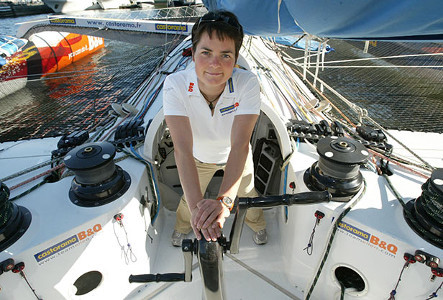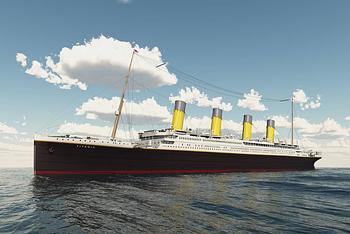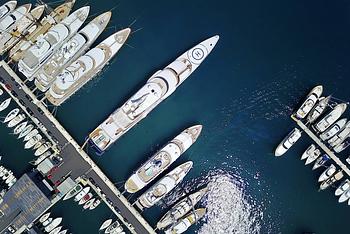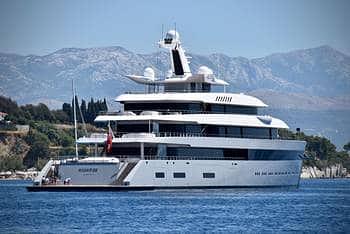Sure, everyone’s familiar with the Columbus, Sir Francis Drake and Captain Cook but when it comes to sailors of the modern era many of the names don’t quite come rolling off the lips. In this article we’ll look at some of the greatest modern sailors – some of whom are household names whilst others may not be quite as familiar.
Sir Peter Blake
New Zealand yachtsman Sir Peter Blake was born on 1st October 1948 and achieved more in his relatively short life than most of us will ever dream of. His domination of world sailing is unrivalled, and his competitive record speaks for itself.
Blake’s career began at the 1973-74 Whitbread Round the World race as watch captain on Les William’s yacht “Burton Cutter”. In the 1977-78 race he returned with Williams on board “Heath’s Condor”, the first boat to race in the competition with a carbon fibre mast. Although the team initially developed a substantial lead in the race, they were undone by a catastrophic rig failure and were placed last on elapsed time after the four legs. Blake returned to the competition in 1981-82 and 1985-86, firstly as skipper of the 68ft sloop “Ceramco New Zealand” designed by Bruce Farr and then as skipper of the Lion Brewery sponsored “Lion New Zealand”.
Blake finally won the competition in 1989-90, when he skippered the famous “Steinlager 2” yacht. He achieved an unprecedented clean sweep of the line, handicap and overall honours on each of the race’s six legs.
Leading the New Zealand team, he won the prestigious America’s Cup twice, first in 1995 and then again in 2000. In the 1995 race, his yacht “Black Magic” beat renowned American sailor and “Mr. America’s Cup”, Dennis Conner 5-0. Blake’s lucky red socks, a present from his wife, became a trademark for success in his homeland with sports fans wearing them or tying them to their car aerials. In 1996, he was inducted into the America’s Cup Hall of Fame.
In 2000, Blake returned to the competition and became the first non-American team to successfully defend the America’s Cup beating the Italian team Prada 5-0. After standing down from the America’s Cup team, Blake became head of expeditions for the Cousteau Society and skipper of the “Antarctic Explorer”, a yacht he later bought and renamed “Seamaster”. He led expeditions to Antarctica and the Amazon during 2001. In the same year he was named special envoy for the UN Environment Programme and began filming documentaries for his own company blakexpeditions.
Tragically Blake’s career was cut short on December 5th 2001, when he was shot and killed by a group of armed pirates known as “the water rats” in a night-time robbery on his boat in the Brazilian Amazon. Blake had returned from dinner with his crew in Macapa when a gang of up to eight men arrived at his boat by rubber dinghy. As the gang made their demands, Blake reached for his gun and shot one of them. In retaliation the robbers opened fire killing Blake and injuring two of his crew. His final log entry of the voyage read, “Status: still motoring. Conditions: pleasant. Dusk has turned the surface of the river into a greasy grey, with the sky quickly darkening after the sun's orange and golds have gone. Again, I raise the question: why are we here? Our aim is to begin to understand the reasons why we must all start appreciating what we have before it is too late. We want to restart people caring for the environment as it must be cared for. We want to make a difference."
Around 30,000 people attended his memorial service including the New Zealand Prime Minister, the Brazilian Ambassador and pop stars Neil and Tim Finn. Carved onto his headstone where the words of John Masefield’s poem, “Sea Fever.” “I must down to the sea again, to the lonely sea and sky, and all I ask is a tall ship and a star to steer her by....".
On October 23rd, 2002, the International Olympic Committee posthumously awarded one of its highest honours, the Olympic Order, to Blake.

Sir Charles “Chay” Blyth
An ex-sergeant in the British Parachute Regiment, in 1971, Blyth became the first person to sail single-handed non-stop westwards around the world on a 59ft boat called “British Steel”. Born in Hawick, Roxburghshire, Scotland in 1940, Blyth began his sailing career whilst still in the army when in 1966, together with Captain John Ridgway, he rowed across the Atlantic in a 20ft open dory called “English Rose III”. This 92-day voyage earned Blyth the award of the British Empire Medal (BEM). He followed this success up in 1968, when he competed in the Sunday Times Golden Globe Race aboard a 30ft yacht named “Dytiscus”.
However, he forced to retire from the race just past the Cape of Good Hope, still an incredible achievement for a sailor of no experience. Blyth achieved household fame in 1971, when he completed the first non-stop westwards around the world voyage in 292 days and earning the title of Commander of the British Empire (CBE). In 1973, he skippered a crew of paratroopers onboard “Great Britain II” and won the Whitbread Round the World Yacht Race. In 1978, he won the Round Britain Race in the yacht “Great Britain IV” and was the first Briton to finish in the Whitbread race of 1981.
In the same year on the yacht “Brittany Ferries GB” he won the Two Handed Trans-Atlantic Race in record time and came second in the Round the Island Race at the Isle of Wight. Blyth came second and first in class in the Round Britain and Ireland Race on the same boat in 1982. Whilst attempting the New York-San Francisco record, he capsized off Cape Horn and was rescued by a passing fishing boat after spending 19 hours in the water. In 1985 and 1986 respectively, he co-skippered with Virgin tycoon Richard Branson on “Virgin Atlantic Challenger” “I” and “II” before founding the Challenge Business to organise the 1992/93 British Steel Challenge.
His success continued in the BT Global Challenge races of 1996/97 and 2000/1. Blyth’s sailing success rubbed off on others as, when in 2005/6, he became mentor to Dee Caffari on her successful bid to become the first woman to sail around the world against the prevailing winds and currents. Perhaps his greatest honour was given to him by his hometown of Hawick when they named a street after him, “Chay Blyth Place”.

Bernard Moitessier
Born in France in 1925, and raised in Vietnam, maverick sailor Bernard Moitessier achieved fame when he participated in the 1968 Sunday Times Golden Globe Race - a race he didn’t even win! His sailing career began as a crew member on Vietnamese sailing trade junks. In 1952, he purchased the dilapidated junk “Marie-Therese” with the aim of slowly sailing to France single handed. The voyage was beset with problems. On the first leg he had to dive underneath the boat to stop it leaking. Then after 85 days he ran aground on Diego Garcia due to lack of modern navigational equipment resulting in him being deported to Mauritius. He worked there for three years and built his own boat which he then sailed via stops in South Africa and St. Helena to the West Indies. Then on a trip from Trinidad to St. Lucia he was shipwrecked due to physical exhaustion.
Finally, he sought work on a cargo ship and returned to France with the aim of earning enough money to build his own boat. He wrote a book about his experiences and this helped fund the building of a 39ft ketch called “Joshua Slocum”. Together with his wife, Francoise, and after leaving their three children in boarding school, he left Marseilles in October 1963, and after wintering in Casablanca sailed to the Canaries, then Trinidad, and through the Panama Canal to the Galapagos Islands. After two years they arrived in Tahiti. Realising they were running out of time to return to their children, Moitessier proposed sailing home eastwards, the quickest route which included the infamous Cape Horn. They arrived back in France at Easter, 1966, and discovered that they had unintentionally completed the longest non-stop passage by a yacht in history, a voyage of 14,216 nautical miles in 126 days. This immediately brought him international recognition from the yachting world.
In August 1968, Moitessier competed in the Sunday Times Golden Globe Race and it was in this event where his legend was born. Leaving Plymouth in the “Joshua Slocum” some months after several smaller and slower craft, he headed south and was off the Cape of Good Hope by October 20th. Whilst transferring a canister of film and reports via a slingshot for the Sunday Times, he collided with a freighter and damaged the bow of his boat. A few days after repairing the damage the craft was knocked flat by a breaking wave. The troubles continued through a succession of gales and calm periods until he passed Cape Horn on February 5th, 1969. In all this time he had no idea of the progress of his competitors. He became depressed and discovered yoga as a means of controlling his moods during the calms of the Indian Ocean. Finally, as he passed Cape Horn, a south-easterly gale started blowing him north once again. Before turning for the Cape of Good Hope he sent a message to the London Times which would define him as both a sailor and as a man. He had decided to abandon the race “because I am happy at sea and perhaps to save my soul.”
He passed up on the chance of a world record and instant fame and sailed on for a further three more months. Although the race was abandoned, he still had circumnavigated the world crossing his path off South Africa and then by sailing almost two-thirds of the way round a second time, mostly in roaring forties. This achievement set a yet another record for the longest nonstop passage by a yacht, 37,455 nautical miles in 10 months. He finally put into Tahiti on the 21st June 1969, thus completing his second personal navigation of the world. Moitessier died of prostate cancer on June 16th, 1994.

Robin Knox-Johnston
Born in Putney, London in 1939, Knox-Johnston served in the Merchant Navy from 1957 to 1965 before sailing his William Atkin’s designed ketch “Suhaili” from Bombay to England in 1965. Lack of funds forced Knox-Johnston to interrupt the voyage and he didn’t complete it until 1967 after working for some time in South Africa. In 1968, he competed against Bernard Moitessier in the Sunday Times Golden Globe Race. Leaving Falmouth in his 32ft boat “Suhaili”, one of the smallest boats to compete, and despite losing his self-steering gear off Australia, he rounded Cape Horn on the 17th January 1969, 20 days ahead of his main rival Moitessier.
Moitessier famously quit the race along with the 7 other competitors, leaving Knox-Johnston as the sole remaining racer. He subsequently won the race and became officially the first person to circumnavigate the globe non-stop and single-handed. In recognition of this feat he was awarded the CBE, Commander of the British Empire. In 1970 (with Leslie Williams) and in 1974 (with Gerry Boxall), he competed in and won the two-handed Round Britain Race. Together with Sir Peter Blake and their crew, he took line honours in the 1971 Cape Town to Rio race. In 1977, again with Blake and Williams, he took line honours in the second and fourth leg of the Whitbread Round the World Race. The partnership with Blake continued to yield success and in 1994, in the Jules Verne Trophy Race they achieved the fastest circumnavigation with a time of 74 days, 22 hours, 18 minutes and 22 seconds. Knox-Johnston’s achievements weren’t just confined to being at sea.
From 1992 to 2001, he was president of the Sail Training Association and trustee of the National Maritime Museum at Greenwich. In 1995, he was created a knight bachelor. Possibly his crowning achievement was to have introduced many people to competitive sailing via his chairmanship of Clipper Ventures, a company he formed to progress the Clipper Round the World Yacht Race to higher levels. In 2007, and at the age of 68, he finished fourth in the Velux 5 Oceans Race, his second solo circumnavigation of the world. In November 2014, the 75 year-old veteran yachtsman competed in the solo transatlantic race Route du Rhum finishing in third place in the Rhum class in a time of 20 days, 7 hours, 52 minutes and 22 seconds.

Ellen MacArthur
Born in Whatstandwell in Derbyshire in 1976, and inspired by Arthur Ransome’s Swallows and Amazons, MacArthur showed an early interest in sailing on a boat owned by her aunt Thea. She saved her school dinner money for three years to buy her first boat, an eight-foot dinghy which she named “Threp’ny Bit”. Whilst studying at school, she worked at a sailing school in Hull. At the age of 17, she bought a Corribee named “Iduna”, a craft she subsequently sailed single-handed on a circumnavigation of Great Britain. In 1997, she finished 17th in the Mini Transat solo transatlantic race in a 21ft Classe Mini yacht she had fitted out herself whilst living in a French boatyard.
She was named British Telecom/Royal Yachting Association “Yachtsman of the Year” in the UK and “Sailing’s Young Hope” in France in 1998. Her fame increased when in 2001, she came second in the Vendee Globe solo round-the-world race in her boat “Kingfisher”. Aged 24, she was the youngest to complete the voyage and was awarded an MBE for services to the sport. Captaining the catamaran “Kingfisher 2”, she attempted the round-the-world record, but fate struck, and her mast broke in the Southern Ocean. In 2004, she failed in her attempt to break the west-east transatlantic crossing aboard the trimaran “B&Q/Castorama” by just around an hour and a half after seven days sailing.
In 2004, the records piled up for MacArthur when she attempted to break the solo record for sailing non-stop around the world. They included the record for the fastest solo voyage to the equator, past the Cape of Good Hope, past Cape Horn and back again. She crossed the finish line near the French coast on the 7th February, beating the previous record by 1 day, 8 hours, 35 minutes and 49 seconds, a world record for the 27,354 nautical miles covered at an average speed of 15.9 knots. In recognition of her achievement, she was made Dame Commander of the Order of the British Empire (DBE), the youngest recipient of the honour.
In 2009, she announced her retirement from competitive sailing and in 2010, launched the Ellen MacArthur Foundation, a charity focusing on the transition to a regenerative circular economy. She had also launched another charity, the Ellen MacArthur Cancer Trust in 2003. MacArthur achieved unintentional media fame with her tearful video diaries which were lampooned and satirised in the BBC show Deadringers and by being the lap record holder on Star in a Reasonably-Priced Car on the motoring show, Top Gear.

Sir Francis Chichester
Of aristocratic heritage, Francis Chichester was born in Shirwell in Devon in 1901. At the age of 18 he emigrated to New Zealand where he built a successful business in forestry, mining and property development. Returning to England in 1929, he took flying lessons and qualified as a pilot. Flying a deHavilland Gypsy Moth, he attempted to break Bert Hinkler’s record solo flight to Australia.
Although beset with mechanical problems and with the record eluding him, he still managed to complete the journey in 41 days. In the same aircraft, he completed the first solo flight across the Tasman Sea from East to West and was the first to land an aircraft on both Norfolk Island and Lord Howe Island. He served in the Royal Air Force Reserve as an Air Navigation Specialist during World War II and after the war founded a successful map-making business. In 1958, he was diagnosed with terminal lung cancer. His wife, Sheila, put him on a strict vegetarian diet and his cancer went into remission. It was then that Chichester turned his attention and remarkable talent for navigation to long-distance yachting.
In 1960, he won the first single-handed transatlantic yacht race which had been founded by the famous “Cockleshell Hero”, ‘Blondie’ Hasler. He then came second in the second race four years later. On 27th August 1966, Chichester set sail from Plymouth in his ketch “Gypsy Moth IV” returning 226 days later on May 28th, having circumnavigated the globe with only one stop, Sydney. He was the first person to achieve a true circumnavigation of the world solo from West to East via the great Capes.
Chichester had wanted to beat the typical times set by a fully crewed clipper ship from the 19th century and the time set by Joshua Slocum in 1898, who took three years and numerous stops to circumnavigate the globe. However, Slocum’s voyage was the harder of the two as he travelled against the prevailing winds from east to west. Chichester was knighted for his achievements in July 1967 and honoured by a newly minted 1/9d postage stamp which featured his boat “Gypsy Moth IV”, going against the tradition of neither being a member of the royal family of being dead at the time of issue. In 1970, he failed by just one day to sail 4,000 miles in 20 days. He died of cancer in Plymouth in August 1972.

Tony Bullimore
To prove that you don’t have to be successful to be a famous, or perhaps infamous sailor, step forward Tony Bullimore. Bristol born Bullimore hit the world’s headlines in 1996. He was competing in the 1996 Vendee Globe single-handed around-the -world race. The race was ill-fated with many incidents including the death of Canadian yachtsman, Gerry Roufs.
On January 5th, 1997, Bullimore’s boat “Exide Challenger” capsized in the Southern Ocean, 2,500km away from the Australian coast. Although the Australian Royal Navy launched rescue attempts for both Bullimore and a fellow capsized competitor, Thierry Dubois, the majority of the press and media assumed the worst and feared he was lost at sea. Bullimore however, was alive and managed to survive in an air pocket in the capsized vessel although he had lost most of his supplies apart from a bar of chocolate. Dubois was rescued on January 9th by an Australian Navy helicopter from HMAS Adelaide.
Meanwhile Bullimore’s craft had been located by a RAAF search and rescue aircraft. HMAS Adelaide sailed towards the site and launched a RHIB to Bullimore’s craft. The crew knocked on the upturned hull. Hearing this Bullimore swam out of his boat and was rescued. He had been stranded under his boat for five days! Bullimore said of his time, “I was thinking, how am I going to be rescued?
From then on in you start to relax and say well, this is it. You think about your life in the past. I'd been married for a good many years, and I was thinking about my family, my friends, what I've done, what I haven't done, what I wanted to do — that kind of thing." The images of Bullimore’s rescue hit the front pages around the globe and he became an international celebrity. In 2005, he skippered a team that came second in the Oryx Quest. Of his rescuers, Bullimore said, "All the guys who jumped on the Adelaide when I was in trouble and went down south to rescue me, I do wish them all the best of luck and if I do ever come to Australia I would like to take them all out for a drink, even one at a time, just to say thank you once again."
At 78 years of age, Bullimore is still sailing today.




